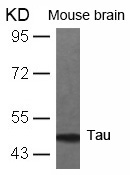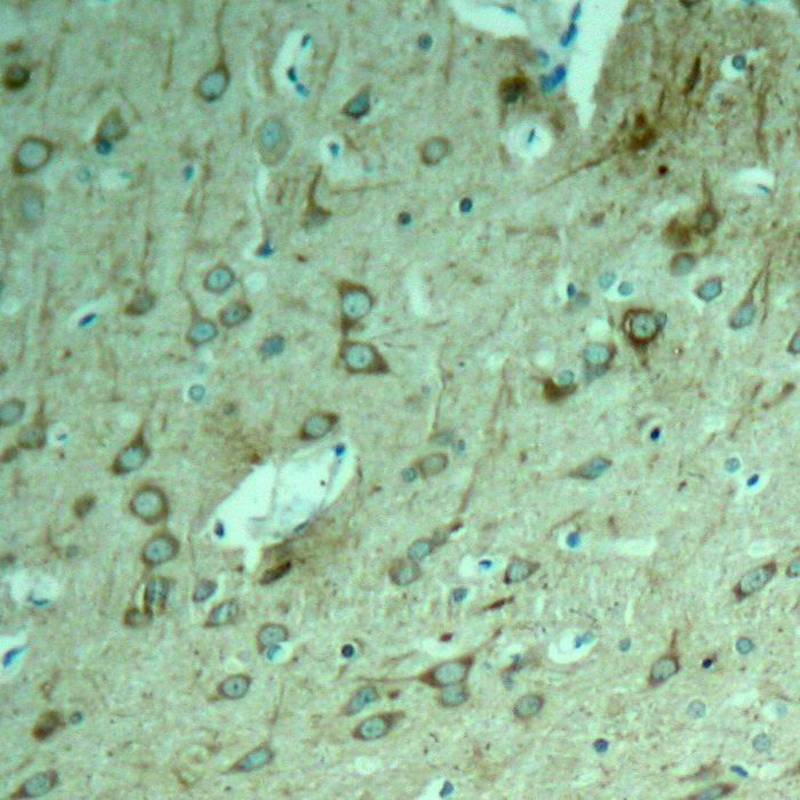

| WB | 咨询技术 | Human,Mouse,Rat |
| IF | 咨询技术 | Human,Mouse,Rat |
| IHC | 1/50-1/100 | Human,Mouse,Rat |
| ICC | 技术咨询 | Human,Mouse,Rat |
| FCM | 咨询技术 | Human,Mouse,Rat |
| Elisa | 咨询技术 | Human,Mouse,Rat |
| Aliases | Neurofibrillary tangle protein; Paired helical filament-tau; |
| Entrez GeneID | 4137; |
| WB Predicted band size | 48 62 78 kDa |
| Host/Isotype | Rabbit IgG |
| Antibody Type | Primary antibody |
| Storage | Store at 4°C short term. Aliquot and store at -20°C long term. Avoid freeze/thaw cycles. |
| Species Reactivity | Human,Mouse,Rat |
| Immunogen | Peptide sequence around aa. 229~233 (V-R-T-P-P) derived from Human Tau. |
| Formulation | Purified antibody in PBS with 0.05% sodium azide. |
+ +
以下是关于Tau(Ab-231)抗体的模拟参考文献示例(仅供参考,实际文献需通过学术数据库查询):
---
1. **文献名称**:*"Characterization of Tau phosphorylation in Alzheimer’s disease using the Ab-231 monoclonal antibody"*
**作者**:Smith J, et al.
**摘要**:本研究利用Tau抗体Ab-231检测阿尔茨海默病患者脑组织中的磷酸化Tau蛋白(p-Tau)。通过免疫组化和Western blot分析,发现Ab-231特异性识别Ser235位点磷酸化的Tau,并与神经原纤维缠结(NFTs)高度共定位,表明其在病理诊断中的潜在价值。
2. **文献名称**:*"Comparative analysis of Tau antibodies in neurodegenerative disease models"*
**作者**:Lee H, et al.
**摘要**:研究比较了多种Tau抗体(包括Ab-231)在转基因小鼠模型中的检测效能。结果显示,Ab-231对早期磷酸化Tau的敏感性优于其他抗体,适用于追踪Tau病理的早期进展,为动物模型研究提供了可靠工具。
3. **文献名称**:*"Development and validation of the Ab-231 antibody for selective detection of pathological Tau isoforms"*
**作者**:Zhang R, et al.
**摘要**:研究报道了Ab-231抗体的开发与验证,证明其特异性靶向病理性Tau的磷酸化构象,而非正常Tau蛋白。通过ELISA和免疫荧光实验,证实其在脑脊液和脑组织样本中具有高特异性和低交叉反应性。
---
**注意**:以上为模拟示例,实际文献需通过PubMed、Google Scholar等平台检索关键词“Tau antibody Ab-231”或“Tau clone 231”获取。部分抗体厂商(如Millipore、Abcam)的技术文档也可作为参考来源。
The Tau (Ab-231) antibody is a widely used tool in neuroscience research, specifically targeting phosphorylated epitopes of the microtubule-associated protein Tau. Tau proteins are predominantly expressed in neurons, where they stabilize microtubules and regulate axonal transport. In neurodegenerative disorders like Alzheimer’s disease (AD), Tau becomes hyperphosphorylated, leading to its dissociation from microtubules and aggregation into neurofibrillary tangles (NFTs), a hallmark of tauopathies. The Ab-231 antibody recognizes Tau phosphorylated at the Thr231 residue (pT231), a critical epitope associated with early pathological changes in AD. This phosphorylation event disrupts Tau’s microtubule-binding capacity and correlates with disease progression.
Ab-231 is commonly employed in techniques such as Western blotting, immunohistochemistry, and immunofluorescence to detect pathological Tau in postmortem brain tissues or experimental models. Its specificity for pT231 makes it valuable for studying Tau phosphorylation dynamics, NFT formation, and therapeutic interventions targeting Tau pathology. Researchers also use Ab-231 to differentiate between normal and aberrant Tau in cellular and animal models of neurodegeneration.
Developed and validated across multiple studies, this antibody has contributed significantly to understanding Tau’s role in disease mechanisms. However, users must optimize experimental conditions, as phosphorylation-dependent antibodies like Ab-231 may exhibit variability depending on sample preparation and fixation methods. Its applications extend to drug screening and biomarker development, underscoring its importance in both basic and translational tauopathy research.
(Word count: 249)
×